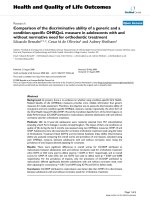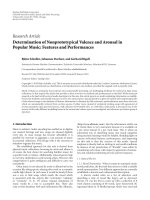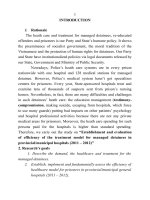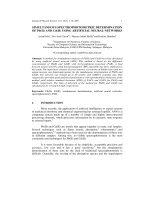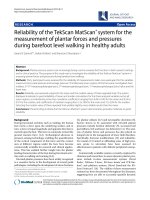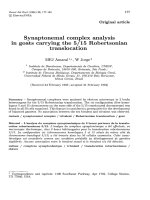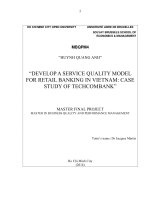Decision model for determination of adaptation potential and renewal action for public housing in singapore
Bạn đang xem bản rút gọn của tài liệu. Xem và tải ngay bản đầy đủ của tài liệu tại đây (3.48 MB, 341 trang )
DECISION MODEL FOR DETERMINATION OF
ADAPTATION POTENTIAL AND RENEWAL
ACTION FOR PUBLIC HOUSING IN SINGAPORE
LIN GUANGMING
(B. Sc. (Accounting, Honours), M. Sc., (CME, Honours),
Chongqing University, China)
A THESIS SUBMITTED
FOR THE DEGREE OF DOCTOR OF PHILOSOPHY
DEPARTMENT OF BUILDING
NATIONAL UNIVERSITY OF SINGAPORE
2011
i
ACKNOWLEDGEMENTS
PhD study is a lonely, painful but rewarding journey. It shapes me to be an independent,
critical and responsible researcher. A number of people have played a role in my research
over the past 3 years. Without them, I cannot imagine how I can achieve my end. They
deserve my deepest acknowledgements.
I indebt my greatest thanks to my supervisor, Professor Teo Ai Lin, Evelyn. Whenever I
need guidance, she always provided her valuable help in my research. I thank her for
helping me go through the most difficult path in the research journey. She is not only my
supervisor, but also my friend and big sister. I deeply appreciate my co-supervisor
Professor Chew Yit Lin, Michael for his valued support to my research and constant
encouragement. I also appreciate my thesis committee member Professor George Ofori
for his invaluable comments on the thesis and advice on my career development.
I am indebted to the examiners who provide valuable comments that improve the quality
of the thesis. My sincere thanks are also to Ms. Jackie and Dr. June for their reading and
helpful comments on the thesis. I am very grateful for the advice offered by Professor
Low Sui Pheng, Professor Fu Yuming and Professor Wong Nyuk Hien. I am grateful to
my fellow graduate students Dr. Shao Dongxu and Dr. Liu Zhiyuan for their help and
friendship.
I would like to acknowledge the officers in the Singapore Housing and Development
Board and the property managers in each Town Council of Singapore who participated in
the survey stage of my research. I would like to thank the Department of Building at the
ii
National University of Singapore for sponsoring my PhD study. My thanks are also to
Ms. Wong Mei Yin, Ms. Nor'Aini Binte Ali in the dean’s office, and Ms. Christabel Toh
in the department general office for their kind help.
My family members: my father, mother, mother-in-law, father-in-law, elder sister, and
two little sisters, they gave me relentless support and encouragement throughout my
research.
Without my wife, I cannot complete my research and the thesis. She sacrificed her career
and came along with me to Singapore to support me. She is the only one who shares with
me the joy and suffering during this journey. I cannot find a single word to describe the
role she plays in my life and my research. The thesis is dedicated to her.
Praise the LORD for His guidance, grace and love.
iii
TABLE OF CONTENTS
ACKNOWLEDGEMENTS I
SUMMARY X
LIST OF TABLES XIII
LIST OF FIGURES XVI
LIST OF ABBREVIATIONS XVIII
CHAPTER 1: INTRODUCTION 1
1.1 Background 1
1.2 Research Problem 4
1.3 Knowledge Gap 5
1.4 Research Aim and Objectives 6
1.5 Research Hypotheses 6
1.6 Definition of Terms 7
1.7 Scope of Research 9
1.8 Research Significance and Contribution 10
1.9 Research Method 11
1.10 Structure of the Thesis 12
CHAPTER 2: PUBLIC HOUSING AND ITS RENEWAL IN SINGAPORE 15
2.1 Introduction 15
2.2 Public Housing in Singapore 15
2.2.1 Public housing agencies 16
2.2.2 New housing development 17
2.2.3 Public housing upgrading 19
2.3 Public Housing Renewal in Singapore 20
2.3.1 Number of various renewal programmes 20
iv
2.3.2 Rationale for renewal programme 22
2.3.3 Decision making processes 24
2.4 Public Housing Renewal in Other Countries 25
2.4.1 Public housing in Hong Kong 26
2.4.2 Public housing in several major developed countries 30
2.5 Summary 36
CHAPTER 3: LITERATURE REVIEW 37
3.1 Introduction 37
3.2 Building Adaptation 37
3.2.1 Definition of building adaptation 38
3.2.2 Reasons for implementing building adaptation activities 39
3.2.3 Various forms of building renewal actions 45
3.3 Review of Building Adaptation Potential 48
3.4 Factors Affecting Building Adaptation Potential 51
3.4.1 Building occupants’ perspective 54
3.4.2 Building system’s perspective 60
3.4.3 Local environmental constraint’s perspective 69
3.4.4 Global environmental constraint’s perspective 70
3.5 The Choice of Building Renewal Actions 74
3.6 Knowledge Gap 77
3.7 Summary 82
CHAPTER 4: CONCEPTUAL FRAMEWORK 84
4.1 Introduction 84
4.2 Research Hypotheses 84
v
4.2.1 Driving forces of building adaptation 84
4.2.2 Determination of building adaptation potential 86
4.2.3 Determination of strategic building renewal actions 96
4.3 Conceptual Framework 98
4.4 Summary 102
CHAPTER 5: RESEARCH DESIGN FOR HOUSE MODEL CONSTRUCTION
AND VALIDATION 103
5.1 Introduction 103
5.2 Method for Building Adaptation Potential Computation 103
5.2.1 Weight elicitation method for each attribute 107
5.2.2 Rating method 110
5.2.3 Aggregation method 112
5.3 Structuring Attributes into a Hierarchy Tree 113
5.3.1 Attributes 113
5.3.2 A Factor-Criterion-Attribute hierarchy tree 115
5.4 Data Collection Design for Attributes 120
5.4.1 Survey research design 120
5.4.2 Public housing policy makers and property managers sample 123
5.4.3 Pilot study 125
5.5 Acquiring Importance Weights for Attributes 126
5.6 Rating Attributes 127
5.7 HOUSE Computation Model 130
5.7.1 Calculating the aggregate score 130
5.8 Validation of the HOUSE Model 131
vi
5.8.1 Purpose of validation 131
5.8.2 Validation methods by others 131
5.8.3 HOUSE model validation 132
5.8.4 Sensitivity analysis 133
5.9 Summary 133
CHAPTER 6: RESEARCH DESIGN FOR ‘3R’ BRA MODEL CONSTRUCTION
AND VALIDATION 135
6.1 Introduction 135
6.2 Monte Carlo Simulation Method for Determining Building Renewal Action 135
6.3 Data Collection for Action Preference Value 139
6.3.1 Interview survey with structured questionnaire 141
6.3.2 Public housing policy makers and property managers sample 141
6.4 Establishing Attribute-Action Database 142
6.5 ‘3R’ BRA Selection Model 143
6.6 Validation of ‘3R’ BRA Model 144
6.6.1 Purpose of validation 144
6.6.2 ‘3R’BRA model validation 145
6.6.3 Sensitivity analysis 146
6.7 Summary 146
CHAPTER 7: DATA PROCESSING AND ANALYSIS 147
7.1 Introduction 147
7.2 Interviewees’ Characteristics 147
7.2.1 Nature of interviewees’ organisations 147
7.2.2 Designation 148
vii
7.2.3 Years in practice 150
7.2.4 Experience in building renewal projects 150
7.3 Data Processing 152
7.4 Reliability of Interview Survey Results 153
7.5 Additional Driving Forces 154
7.6 Comments on the HOUSE and ‘3R’ BRA Models 154
7.7 Summary 157
CHAPTER 8: EMPIRICAL FINDINGS OF DRIVING FORCES OF BUILDING
ADAPTATON 158
8.1 Introduction 158
8.2 Descriptive Analysis of driving forces and facilitator 158
8.2.1 Building deterioration 161
8.2.2 Housing obsolescence 162
8.2.3 Sustainable requirements 163
8.3 Additional Driving Forces 166
8.5 Summary 167
CHAPTER 9: HOUSE MODEL CONSTRUCTION, APPLICATION AND
VALIDATION 169
9.1 Introduction 169
9.2 Survey Results and Statistical Analyses for Attributes 169
9.2.1 Mean importance ratings 169
9.2.2 Statistical test of the mean 172
9.2.3 Statistical analyses 173
9.3 HOUSE Model Construction 192
viii
9.3.1 Inputs of HOUSE model construction 192
9.3.2 Attributes 194
9.3.3 Criteria 196
9.3.4 Factor 198
9.3.5 Importance weights (a hierarchy tree) 202
9.3.6 Ratings of attributes 204
9.3.7 Aggregation formula 204
9.4 HOUSE Model Application 207
9.5 Sensitivity Analyses for HOUSE model 214
9.6 HOUSE Model Validation 215
9.6.1 The BAP values derived from the professionals’ judgement 219
9.6.2 The BAP values generated by the HOUSE model 220
9.6.3 Comparison of the BAP results from the two sources 224
9.7 Professionals’ Comments on HOUSE Model 226
9.8 Summary 227
CHAPTER 10: ‘3R’ BRA MODEL CONSTRUCTION, APPICATION AND
VALIDATION 229
10.1 Introduction 229
10.2 Preference Value for Building Renewal Action 229
10.2.1 Mean preference value (MPV) for each action 229
10.2.2 Attribute-Action database 242
10.3 The Relationship between BAP and BRA 248
10.3.1 Attribute-Action matrix 248
10.3.2 Monte Carlo simulation results 251
ix
10.4 The ‘3R’ BRA Model Application 254
10.4.1 Description of the case building 254
10.4.2 Rating of each attribute 255
10.4.3 The choice of the BRA 257
10.5 ‘3R’ BRA Model Validation 261
10.5.1 The renewal action chosen by the professionals’ own judgement 261
10.5.2 The renewal action recommended by the ‘3R’ BRA model 263
10.5.3 The comparison of renewal actions suggested by the two sources 264
10.6 Professionals’ Comments on ‘3R’ BRA Model 266
10.7 Sensitivity Analyses for ‘3R’ BRA Model 267
10.8 Summary 268
CHAPTER 11: CONCLUSIONS AND RECOMMENDATIONS 270
11.1 Introduction 270
11.2 Conclusions 270
11.3 Research Significance 274
11.3.1 Contribution to knowledge 274
11.3.2 Contribution to practice 276
11.4 Limitations of Research 277
11.5 Recommendations for Future Research 279
REFERENCES 281
APPENDIX A: INTERVIEW SURVEY STRUCTURED QUESTIONNAIRE 306
APPENDIX B: PROGRAMME CODE FOR MONTE CARLO SIMULTION 317
APPENDIX C: PUBLICATIONS 320
x
SUMMARY
Sustainable development has become a worldwide concern and a topical issue in
Singapore. Singapore is a city-state with constrained natural resources. When Singapore
transits to a more advanced stage, it has to be benchmarked against international
sustainable standards and norms. This brings a challenge as well as opportunity to the
public housing sector, as it dominates in the total building stock in Singapore (accounting
for about 83.77 per cent of the total building units) and accommodates 82 per cent of
Singaporeans. Public housing would therefore have great implications for Singapore’s
sustainable development.
In recent years, the significance of using building adaptation to deliver building
sustainability has been acknowledged. However, a constrained financial budget compels
policy decision makers with substantial public buildings to find solutions to the problems
of which building needs adaptation, and which level of intervention the building should
receive. A sound solution is to prioritise these buildings according to their adaptation
potentials and select those with high needs to be adapted. When the adaptation potential
for a given building is identified, the building demands a suitable remedial response,
which is termed as building renewal action.
This research aims to explore the decision making for determination of building
adaptation potential (BAP) and building renewal action (BRA). The particular objectives
include developing a framework for the calculation of building adaptation potential and
establishing the quantitative relationship between the BAP and the BRA to advise
decision makers on strategic renewal actions. The survey method is adopted to attain
xi
these objectives. The data collection instrument is a structured questionnaire.
Furthermore, data are collected using a face-to-face interview approach involving 49
decision makers in the Singapore Housing and Development Board (HDB) and sixteen
town councils (TC) of Singapore.
The results show that the main driving forces of building adaptation are building
deterioration and housing obsolescence, while its facilitator is sustainable requirements.
In addition, the multi-attribute value technique (MAVT) is used to elicit the BAP value
for specific buildings by multiplying the rating for each attribute by its importance weight
and summing up the products over all the attributes. The findings indicate that occupants’
attitude, housing obsolescence, prospective impacts related to adaptation activities and
building sustainability performance have a profound effect on BAP values. According to
the BAP elicitation model, its value theoretically ranges from 0 to 219.55, where 0 means
that a building has no desirability to be renewed and 219.55 implies that the building has
the maximum desirability to be renewed.
The decision making for determination of the BRA is explored as well. Three renewal
actions including retaining, renovating and rebuilding (‘3R’) are proposed in this
research, which represent three strategic levels of renewal actions that decision makers
could consider when renewing a building. The finding implies that a renewal action with
a maximum total preference value assigned by decision makers is the desirable option for
a studied building.
xii
Furthermore, the study of the boundaries for the three renewal actions based on the range
of the BAP values is conducted. The BAP elicitation mechanism along with other inputs
is incorporated into Monte Carlo simulation. The simulation generates a clear distribution
of the three renewal actions, indicating that if the BAP value of a specific building is less
than 140, the renewal action of ‘retaining’ will be desirable for the decision makers;
conversely, if its BAP value is greater than 180, the action of ‘rebuilding’ will be a
beneficial choice; if its BAP value is within the range of 140 to 180, the action of
‘renovating’ should be considered. In other words, the boundary values for the ‘3R’
renewal actions are 140 and 180 respectively. These findings support the proposition that
building adaptation potential influences the choice of building renewal actions. These
results are validated by applying the BRA model to real-life cases in Singapore.
This research makes contributions by proposing the BAP determination model and BRA
model. Policy decision makers can utilise the BAP model to establish an inventory
representing the adaptation potentials for existing public buildings under management.
For a given financial budget, the next stage for them is to prepare a shortlist of the most
appropriate buildings with greatest adaptation potentials. Furthermore, the BRA model
extends the understanding of how strategic renewal actions can be chosen for the
shortlisted buildings. Lessons learnt from this research would assist decision makers who
manage substantial public buildings in other countries in finding solutions to the
problems of buildings needing adaptation and the appropriate level of intervention.
Keywords: Building adaptation, building adaptation potential, building renewal action,
public housing, sustainable development, Singapore.
xiii
LIST OF TABLES
Table 1.1: Water and electricity use, waste generated in Singapore and other cities 3
Table 2.1: Public housing units constructed since 1960 18
Table 2.2: The number of precincts for each renewal programme under the ERS 21
Table 2.3: Building adaptation criteria by the HDB 23
Table 2.4: The focus areas and scopes of housing renewal programmes 23
Table 2.5: Facts and figures in Hong Kong’s public housing programme 27
Table 2.6: The focus and scope of housing improvement programmes in Hong Kong 28
Table 2.7: Public housing sector in several major developed countries 31
Table 3.1: Scale and degree of changes for building adaptation 48
Table 3.2: Factors and their assessment attributes for building adaptation potential 52
Table 3.3: Criteria measuring technological obsolescence for buildings 65
Table 3.4: The ranges of building environmental assessment tools 73
Table 4.1: Factors and their assessment criteria (attributes) in Hypothesis 2 95
Table 5.1: The rating system in the MAVT 128
Table 6.1: A hypothetical example about how to derive the Attribute-Action Database 142
Table 7.1: Designation of policy makers in the HDB 148
Table 7.2: Designation of property managers interviewed from town councils 149
Table 7.3: Years in practice for interviewees 150
Table 7.4: Number and type of renewal projects involved 151
Table 8.1: Mean ratings for the proposed driving forces and facilitator 160
Table 9.1: Mean importance ratings of attributes 171
Table 9.2: Respondents’ survey results for building occupants’ attitude 174
xiv
Table 9.3: Respondents’ survey results for housing obsolescence 180
Table 9.4: Respondents’ survey results for prospective impacts 187
Table 9.5: Respondents’ survey results for urban planning policies 189
Table 9.6: Respondents’ survey results for building sustainability performance 190
Table 9.7: Importance weights of attributes 194
Table 9.8: Importance weights of individual criteria 196
Table 9.9: A sample of the ratings for two attributes 204
Table 9.10: BAP computation processes 206
Table 9.11: The features of the three case buildings and interview results 209
Table 9.12: The computation processes for BAP
1
210
Table 9.13: BAP results for the cases 2 and 3 buildings 213
Table 9.14: The particulars of the professionals 216
Table 9.15: The features of the case buildings for the HOUSE model validation 217
Table 9.16: The BAP values for the nine buildings using the professionals’ measurement
220
Table 9.17: The BAP values for the nine buildings using the HOUSE model 222
Table 9.18: The BAP results derived from the two sources 224
Table 9.19: Professionals’ comments on the HOUSE model 226
Table 10.1: MPV for each action under occupants’ attitude 231
Table 10.2: MPV for each action under housing obsolescence 235
Table 10.3: MPV for each action under expected impacts 238
Table 10.4: MPV for each action under urban planning policies 240
Table 10.5: MPV for each action under building sustainability 241
xv
Table 10.6: Attribute-Action Database 244
Table 10.7: The rating of each attribute based on the case building 256
Table 10.8: Sensitivity analysis results for the case study 260
Table 10.9: The renewal actions chosen by the professionals’ measurement 262
Table 10.10: The renewal actions recommended by the ‘3R’ BRA model 264
Table 10.11: The comparison of renewal actions by two approaches 265
Table 10.12: Professionals’ comments on the ‘3R’ BRA model 266
xvi
LIST OF FIGURES
Figure 1.1: Research method 11
Figure 2.1: The organisation for renewal programme decision-making 25
Figure 3.1: The impact of adaptation on deterioration 41
Figure 3.2: Building renewal strategies of constructed facilities 46
Figure 3.3: The range of building renewal strategies 47
Figure 3.4: Relationship between utility scale and building adaptation (Adapted from
Nutt et al. (1976)) 56
Figure 4.1: The causes of building adaptation 86
Figure 4.2: Factors and their corresponding criteria influencing the BAP 91
Figure 4.3: The choice of building renewal action (BRA) 98
Figure 4.4: Conceptual framework for this study 101
Figure 5.1: Rating scale used by Kometa (1995) 111
Figure 5.2: Rating scale used by Motowidlo and Van Scotter (1994) 111
Figure 5.3: Multi-attribute computation tool for building adaptation potential 119
Figure 6.1: ‘3R’ BRA model for establishing the relationship between BAP and BRA 137
Figure 6.2: Attribute-Action matrix 139
Figure 6.3: Boundaries for the three building renewal actions 144
Figure 8.1: The presentation of driving forces and facilitator of building adaptation
activity using the graph algebra 165
Figure 9.1: The framework for the computation of building adaptation potential 193
Figure 9.2: Weights of attributes, criteria and factors under investigation 203
Figure 9.3: The profiles of the selected buildings (case 1, 2 and 3) 208
xvii
Figure 9.4: Sensitivity analysis result for each factor’s impact on the BAP score 215
Figure 9.5: The profiles of the nine selected buildings 219
Figure 10.1: The conceptual Attribute-Action matrix for this study 249
Figure 10.2: The overall approach to attain the desired building renewal action 251
Figure 10.3: The quantitative relationship between the degree of the BAP and ‘3R’ BRA
253
Figure 10.4: The profile of the selected building 255
Figure 10.5: The Attribute-Action matrix for the case building 259
Figure 10.6: The distribution of ‘3R’ BRA with 1000 samples 267
Figure 10.7: The distribution of 3R’ BRA with 500 samples 268
xviii
LIST OF ABBREVIATIONS
BAP: Building Adaptation Potential;
BCA: Singapore Building and Construction Authority
BRA: Building Renewal Action;
ERS: Estate Renewal Strategy;
EUP: Private Estate Upgrading Programme;
HDB: Singapore Housing and Development Board;
HA: Hong Kong Housing Authority;
HD: Housing Department;
HIP: Home Improvement Programme;
HOUSE: Housing obsolescence, Occupants’ attitude, Urban planning policies,
Sustainability performance and Expected impacts;
HUP: Hacker Centre Upgrading Programme;
IMCSD: Inter-Ministerial Committee on Sustainable Development
IUP: Interim Upgrading Programme;
IUP plus: Interim Upgrading Programme plus Lift Upgrading Programme;
LUP: Lift Upgrading Programme;
MAVT: Multi-attribute Value Technique;
MND: Singapore Ministry of National Development;
MPV: Mean preference value;
MUP: Major Upgrading Programme;
NRP: Neighbourhood Renewable Programme;
ROS: Revitalisation of Shop Scheme;
R&R: Repair and Repainting;
RUP: Rental Upgrading Programme;
SERS: Selective En-bloc Redevelopment Scheme;
TC: Town Council;
3R: Retaining, Renovating, Rebuilding.
1
CHAPTER 1: INTRODUCTION
1.1 Background
Sustainable development has become a worldwide concern (Bossel, 1999; Krajnc and
Glavič, 2005), which requires resources to be preserved, the ecology to be protected, and
a healthy living environment to be maintained (Kibert, 1994). It is also a topical issue in
Singapore. As a small city-state, Singapore has finite space (a land area of 712.4 sq. km)
and limited natural resources, and heavily depends on imported energy and water. For
instance, it imported 99.84% of energy (The World Bank, 2009) and 40% of water (Oon,
2009) in 2009. As a major energy consumption and water consumption sector, public
housing can play an important role in addressing Singapore’s sustainability issues. In
response to the sustainability issues, the Singapore government has set up an Inter-
Ministerial Committee on Sustainable Development (IMCSD, 2009). The committee has
published a “Sustainable Development Blueprint” in 2009 that contains targets and
initiatives needed for Singapore’s sustainable development. These key targets include a
35% improvement in energy efficiency from 2005 levels by 2030 and a waste recycling
rate of 70% by 2030, reduction of domestic water use to 140 litres per person per day by
2030 (IMCSD, 2009, pp.2, pp.14).
Existing public housing can play a role in Singapore’s sustainable development, in
particular for addressing the challenges associated with its environmental sustainability.
First, public housing dominates in the total building stock of Singapore, accounting for
83.77 per cent of the total building units (HDB, 2011a; Statistics Singapore, 2012).
2
Second, it accommodates about 82 per cent of the total population in Singapore (HDB,
2010a). Third, as more than 95 per cent of public estates in Singapore are sold to
residents on 99-year leases, they may have a long-term environmental, economic and
social impacts (Yu, 2004).
Its contribution may be attained through building adaptation, as the implications of
building adaptation to environmental sustainability have been acknowledged (Langston et
al., 2008; Wilkinson et al., 2009). Wilkinson et al. (2009) stated that building adaptation
is inherently sustainable compared to new build work, as the former normally consumes
less physical resources like water and energy, and causes less air pollution during
construction.
Although the Singapore public housing agency (better known as the Housing and
Development Board (HDB)) has implemented a great number of adaptation programmes,
the resource efficiency for existing residential buildings is relatively low compared to
other international cities, e.g. Hong Kong. As Singapore transits to a more advanced
developmental stage, it has to be increasingly benchmarked against international
sustainable norms and standards. Compared to Hong Kong, Melbourne, and Rotterdam,
for example, Singapore performs relatively poor in domestic water consumption per
capita per day (see Table 1.1). In terms of domestic electricity consumption, Hong Kong
and Melbourne also outperform Singapore.
3
Table 1.1: Water and electricity use, waste generated in Singapore and other cities
Indicators
Singapore
Hong Kong
Melbourne
Rotterdam
Domestic water consumption
(unit: liters/ capita/day)
154
130
140
124
Electricity consumption
(unit: Kwh per capita per year)
7,949
5,925
6,300
-
Total municipal waste
(unit: kg/ capita)
543.66
468.7
-
-
Sources: MEWR, 2011; The Victorian Government, 2011; Rotterdam Climate
Initiative, 2011; Water Supplies Department, 2011; The World Bank,
2010;
DSE, 2007;
It can be partially attributed to the fact that although these upgrading programmes have
generated economic benefits and social benefits by providing such as better lift or
electrical supplies, resource use profile and environmental impact profile were not
adequately captured in current public housing adaptation decision making practice in
Singapore. For example, one scope of the Home Improvement Programme (HIP) (shown
in Table 2.4) is to replace refuse hopper but not to alter the municipal waste collection
system that may encourage public housing occupants’ recycling behaviour. Since
Singapore has constrained natural resources and limited carrying capacity like absorbing
waste generated, understanding the resource use profile and environmental impact profile
for the existing public housing becomes increasingly important.
The fact that an increasing number of ageing public estates in Singapore are in constant
need of adaptation to continuously fulfil their designed function (Yu, 2004) compounds
the situation. These coupled effects place great pressure on the government as substantial
financial expenditure is required for those buildings to be adapted. Decision makers in the
Singapore public housing sector therefore become more keen to find scientific manners to
choose buildings for adaptation, and to identify suitable level of intervention that these
4
buildings deserve, with the aim of enhancing the efficiency of limited financial resources
and natural resources (Das et al., 2010; Rosenfeld and Shohet, 1999).
1.2 Research Problem
Given the complex nature of public housing adaptation management, the decision making
requires sensitivity to issues like uncertainty, multiple objectives and conflicting values
systems among stakeholders. In addition, to harvest the opportunity of delivering
environmental sustainability via building adaptation, the need of taking account of
environmental sustainability requirements in building adaptation decision-making would
place additional stress on thinking and rationality (Sobotka and Wyatt, 1998; Wilkinson
et al., 2009). To assist decision makers in thinking through this complex decision
problem, “a quantitative framework is required to encourage consistency, the essence of
rationality” (Watson and Buede, 1987, pp.18). Furthermore, the mass-scale public
housing upgrading programmes propel policy decision makers to explore a more
scientific way that is able to help them differentiate and choose appropriate building
renewal actions, instead of making such decisions based on heuristic knowledge or ‘rules
of thumb’ (HDB, 2007b; 2008).
A quantitative decision support framework that is able to identify the adaptation potential
for a given building and its corresponding renewal strategy therefore becomes imperative.
It would alleviate the dilemma facing decision makers who often desire to find solutions
to the problem of dwellings needing adaption and identify appropriate level of
intervention they should implement (Rosenfeld and Shohet, 1999). The outcomes of the
research are able to help the decision makers make such decisions in a consistent and
5
justifiable manner. On the one hand, that would help them mitigate the debates among
different stakeholders over the decision results. On the other hand, it would facilitate the
decision making process.
1.3 Knowledge Gap
The literature review (see chapter 3) reveals that previous research on building adaptation
primarily focused on: (1) discussion of building adaptation definition; (2) investigation of
reasons for carrying out building renewal projects; (3) classification of building renewal
actions; (4) exploration of factors relevant to the determination of building adaptation
potential; and (5) discussion of the choice of building renewal actions.
From the literature review, several knowledge gaps that motivated this research were
identified (refer to Section 3.6 for the detailed discussion):
(1) Building adaptation research inadequately addressed the issue of how building
occupants’ attitude would impact building adaptability (refer to: Low, 1996; Yu,
2004).
(2) Previous studies in this field have not sufficiently taken account of sustainability
assessment criteria (e.g. energy consumption) in the computation of building
adaptation potential (see: Kincaid, 2002; Wilkinson et al., 2009).
(3) There was a scarcity literature on a systematically theoretical way that can assist
decision makers in identifying building adaptation potential by revealing the impacts
of occupants’ attitudes, housing obsolescence before adaptation, expected impacts
associated with adaptation, building sustainability performance before adaptation and
